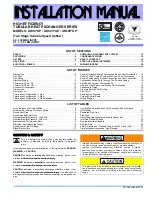
Page 4
vent chilled air from entering the furnace. If the damper is
manually operated, it must be equipped to prevent operation
of either the heating or the cooling unit, unless it is in the full
HEAT
or
COOL
setting. See figure 1.
FIGURE 1
Gas Unit
Heating Unit Installed Upstream of Cooling Unit
Gas Unit
Dampers
(open during heating operation only)
Dampers
(open during cooling operation only)
Heating Unit Installed Parallel to Cooling Coil
Cooling Coil
Cooling Coil
When installed, this furnace must be electrically grounded
according to local codes. In addition, in the United States,
installation must conform with the current National Elec
tric Code, ANSI/NFPA No. 70. The National Electric Code
(ANSI/NFPA No. 70) is available from the following ad
dress:
National Fire Protection Association
1 Battery March Park
Quincy, MA 02269
NOTE - Do not set thermostat below 60°F (16°C) in heat
ing mode [or 55°F (13°C) when furnace is operated over
night in setback mode]. Setting thermostat below 60°F
(16°C) reduces the number of heating cycles. Return air
temperature must not exceed 85°F (29°C) dry bulb. Dam
age to the unit may occur that is not covered by the war
ranty
The 80AF1UH furnace may be installed in alcoves, closets,
attics, basements, garages, crawl spaces and utility rooms
in the upflow or horizontal position.
This furnace design has not been CSA International
certified for installation in mobile homes, recreational
vehicles, or outdoors.
Use of Furnace as Construction Heater
It is not recommended using 80AF1UH units as a construc
tion heater during any phase of construction. Very low re
turn air temperatures, harmful vapors and operation of the
unit with clogged or misplaced filters will damage the unit.
80AF1UH units may be used for heating of buildings or
structures under construction, if the following conditions
are met:
D
The vent system must be permanently installed per
these installation instructions.
D
A room thermostat must control the furnace. The use of
fixed jumpers that will provide continuous heating is not
allowed.
D
The return air duct must be provided and sealed to the
furnace.
D
Return air temperature range between 60°F (16°C) and
80°F (27°C) must be maintained.
D
Air filters must be installed in the system and must be
maintained during construction.
D
Air filters must be replaced upon construction comple
tion.
D
The input rate and temperature rise must be set per the
furnace rating plate.
D
One hundred percent (100%) outdoor air must be pro
vided for combustion air requirements during construc
tion. Temporary ducting may supply outdoor air to the
furnace. Do not connect duct directly to the furnace.
Size the temporary duct following these instructions in
section for Combustion, Dilution and Ventilation Air in a
confined space with air from outside.
D
The furnace heat exchanger, components, duct system,
air filters and evaporator coils must be thoroughly
cleaned following final construction clean-up.
D
All furnace operating conditions (including ignition, in
put rate, temperature rise and venting) must be verified
according to these installation instructions.
General
These instructions are intended as a general guide and do
not supersede local codes in any way. Consult authorities
having jurisdiction before installation.
In addition to the requirements outlined previously, the fol
lowing general recommendations must be considered
when installing a 80AF1UH furnace:
Place the furnace as close to the center of the air dis
tribution system as possible. The furnace should also be
located close to the chimney or vent termination point.
Do not install the furnace where drafts might blow direct
ly into it. This could cause improper combustion and un
safe operation.
Do not block the furnace combustion air openings with
clothing, boxes, doors, etc. Air is needed for proper
combustion and safe unit operation.





































